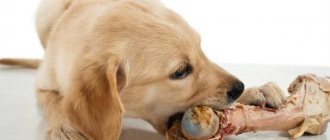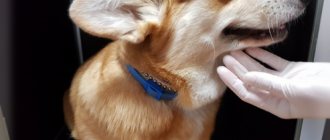Every person who decides to get a puppy must understand that along with a cute little bundle, a source of positivity and joy in the family, it acquires a lot of problems - damaged furniture, chewed-up shoes, wool all over the house. You will probably have to deal with your pet’s desire to make different sounds regardless of the time of day, bark, whine and howl.
And if there are several dogs, sometimes they put on a real concert! It's hard to bear such polyphony. The situation is getting out of control, and not only household members, but also everyone living nearby are suffering from constantly barking dogs.
Is this advisable?
This problem should not worry owners of private houses.
There, loud barking dogs are taken for granted. But in multi-story buildings, the ringing voice of a pet can annoy neighbors. To avoid conflict situations, some owners decide to cut the ligaments of their pet. But is this really necessary?
Such interference in nature is associated with risks for the animal. You need to weigh everything carefully before exposing your dog to stress for the sake of disgruntled neighbors.
Possible complications
- Bleeding and swelling of the larynx.
- Infection. This complication is not only associated directly with the operation, but can also occur in the postoperative period. Since the larynx and trachea are areas that cannot be completely sterile. There is always a risk of infection from food.
- Excessive scarring. This complication can only be detected some time after the intervention and will significantly complicate the animal’s life. It will be difficult for him to swallow, breathing will be difficult and fluid will accumulate in the larynx.
- Risk of developing pneumonia. Occurs in the event of an error during surgery, when, due to inexperience or carelessness, an animal’s nerve is touched.
Types of surgery
The purpose of the procedure is to deprive the pet of the “right to vote.”
Surgeons practice 2 methods of cutting:
- if partial, they are cauterized with electric current or cut with instruments;
- when complete, the ligaments are removed and the cut sites are cauterized.
In the first case, the dog will be able to restore its voice, but it will no longer be as ringing and loud. After the second operation, the pet will not bark at all .
Process description
The procedure itself takes no more than 40 minutes. The same amount of time will be spent on blood sampling and analysis.
The intervention technique looks like this:
the anesthesiologist administers anesthesia to the animal;- the dog's head is raised;
- a special device is inserted into the mouth to fix the jaws in an open state;
- surgical scissors are used to make incisions in the ligaments or completely cut them off;
- After packing, the wounds are treated with hemostatic drugs.
The procedure does not require special equipment. Some veterinarians practice surgery at home, where psychologically the animal is subject to less stress.
Expert opinion
Panteleeva Irina Petrovna
Breeder, 11 years experience.
As for the hygienic side, this is a controversial point. In addition, an on-site session is more expensive.
Causes and symptoms
The disease is provoked by a number of harmful factors:
- viral diseases of the expectant mother;
- pathologies of the placenta at the stage of intrauterine development;
- Rhesus conflict;
- fetal hypoxia;
- very rapid or slow labor with cerebral hemorrhage in the child;
- some birth injuries;
- prematurity;
- infections of the brain and its membranes, such as meningitis;
- Cerebral palsy (up to 85% of cases of dysarthria);
- TBI;
- hydrocephalus;
- severe intoxication;
- encephalitis. Source: L.I. Belyakova, Yu.O. Filatova Diagnosis of speech disorders // Defectology, 2007
Alternative to surgery
Ligament cutting is not a new trend that people are trying to follow, but a last resort.
Before turning to this technique, it is worth considering other options. There are alternative methods that do not harm the animal.
Dog training
There are dog breeds for which incessant barking is a distinctive feature. But most often, ill-mannered individuals raise their voices for no reason.
Training is applied to service dogs, forgetting that small, decorative breeds also need training. By teaching your pet to voice in specific cases, you can avoid a showdown with your neighbors.
Use of sedatives
Dogs bark or howl for a long time out of loneliness: they are locked in an apartment and feel sad.
To prevent the animal from getting excited about this and terrorizing others with loud sounds, it can be given a sedative before leaving.
Your veterinarian will tell you which medications to use..
He will also determine the dosage based on the breed and age of the pet.
Examination by a veterinarian to rule out diseases
A well-mannered dog may show anxiety even in the presence of its owners. This is already a reason to show the animal to a specialist. Perhaps your pet is in pain and is asking for help in a loud voice.
Expert opinion
Makarenko Svetlana Igorevna
Practicing veterinarian, 15 years of experience.
In rare cases, unmotivated barking is a sign of mental pathologies that are inherited. In such a situation, surgery may be the only option to solve the problem.
How much does a ventriculocordectomy cost?
The price of the operation depends on many factors - the city, the reputation of the clinic and the professionalism of the veterinarian, as well as the dog’s body weight. The cost varies from 6,000 to 15,000 rubles. It should be taken into account that not every veterinary hospital offers such services, so you may have to go to another region. Accordingly, costs will increase.
However, there is an alternative option - to gather a group of dog breeders who are faced with such problems and invite a veterinarian to your city to perform the operation.
Pros of the operation
When talking about the benefits of pruning, only one positive point comes to mind. It is connected with the degree of comfort of the owner:
I don’t want to quarrel with my neighbors over a dog;- I also don’t want to strain myself with training;
- you need to constantly spend money on sedatives;
- I also don’t like the “Antilai” collar.
It’s easier to pay for the operation and then calmly coexist with those around you and your silent pet.
Why does a dog bark and how to stop it?
There are many reasons that prompt a dog to bark: illness, stress, poor living conditions, longing for its owner, sexual activity, lack of education, the desire to confirm its leadership, etc.
Often the owner is not able to solve this problem on his own, and in some cases it is useless, because there are dogs that have this desire at the genetic level, for example, representatives of herding breeds. Animals simply follow their instincts.
Sometimes the situation takes on enormous proportions, to the point where the question of euthanasia or changing the owner arises. Many owners are not ready to solve the problem with radical methods and are looking for alternative methods. They certainly exist.
For example, special “Anti-bark” collars are effective, the action of which consists of a weak current discharge or spraying the dog with water. Some people prefer to turn to specialists for competent professional training and behavior correction.
Well, if these methods do not help, it is advisable to contact a veterinary clinic for surgery to remove the vocal cords. In any case, the procedure, the essence of which is to “turn off the function” of barking, is more humane than daily punishments, and especially euthanasia.
By the way, in some European countries such an operation is considered ordinary and is carried out en masse.
Negative aspects of intervention
There is only one argument in favor of the operation, and it is not so significant. But the procedure has plenty of disadvantages:
- Pruning is carried out under general anesthesia, and it has a negative effect on the heart. Many dogs suffer from heart failure, mostly toy breeds. This pathology is asymptomatic, so there is a risk of death caused by anesthesia.
- Due to surgery or exposure to current, the animal may develop laryngeal edema. As a result, the dog suffocates and dies. Everything happens so quickly that the doctor does not have time to take resuscitation measures.
Silencing a pet causes psychological trauma. The dog can no longer communicate with its own kind and becomes a kind of outcast. It is not always possible to find a common “language” with the owner - animals do not know how to express themselves with gestures and facial expressions. All this depresses the animal; it refuses to eat, walk, and gradually withers away.- The opposite situation is also possible: the animal becomes aggressive and attacks everyone. Here another problem will arise - the need for isolation (and, perhaps, euthanasia).
- In the case where the ligaments were not removed, but were only slightly trimmed, the animal barks, but in a “whisper.” In apartments with poor sound insulation, such sounds can annoy neighbors even more. It will also be difficult for the pet to communicate with other dogs: the vibrations in the voice change, making the dog a “foreigner” among his fellow tribesmen.
But the most serious argument is an unqualified operation.
Domestic veterinarians are not trained in this technique. There are only a few clinics certified for this service in Russia, so the risk of complications after a poorly performed operation is high.
After weighing the pros and cons, you should think several times whether such a procedure is justified. After all, an inexperienced doctor can accidentally touch the walls of the larynx, causing severe bleeding. Losing a pet is not worth the money (and there is a lot of it) spent on depriving a dog of his voice.
Vocal cord cutting in dogs
The method of cutting vocal cords is gradually gaining popularity among pet owners. This step has long been practiced in developed countries of the world, but in Russia, for the most part, such operations cause a negative reaction.
The procedure is often compared with castration or sterilization, when the chosen step to solve the problem is very ambiguous. Despite the huge mass of conflicting reviews, correction of the vocal cords takes place if the owner does not have enough time to teach the dog to be silent without surgical intervention.
Caring for the animal after the procedure
If the negative aspects do not frighten the owner, and he is sure that the operation is extremely necessary, he will have to take care of the dog’s further well-being.
The injured throat is cooled immediately after surgery, so there is no need to treat it specially.
Basic care is as follows:
- the first day requires complete rest;
- for a week after surgery, the dog is not given solid food or dry food;
All toys are hidden away during the rehabilitation period so that the dog does not chew them;- no physical activity for 2 weeks;
- The animal, as before, is taken for walks, but they should be measured, without the usual games.
It is important to protect the dog from all kinds of stress during rehabilitation. The animal needs the attention of its owners. It must feel important. Whether the ligaments are removed or not, the dog still remains a pet.
Brachycephalic obstructive syndrome. Interview with a surgeon
With this interview, we open a series of publications based on materials from lectures given by Biocontrol doctors at meetings of the BioClub, the school of responsible ownership.
We talked about brachycephalic obstructive syndrome, the causes of its occurrence, stages of development and treatment with the leading surgeon, endosurgeon of Biocontrol, Lev Valerievich Golub.
- So, brachycephalic syndrome. What is this?
— Brachycephalic obstructive syndrome. It is obstructive, from the Latin obstructio - hindrance, obstacle, because this word adds and explains the severity of this condition. Brachy - short, cephalo - relating to the head. Together, this indicates a shortened skull, or more precisely, a shortened facial part of the skull.
This syndrome means that the animal has an obstruction to the air it can breathe.
— What breeds are brachycephalic and are predisposed to this syndrome?
— French and English bulldogs probably take first place. Next come pugs and other breeds: griffins, shih tzus, pekingese, boston terriers.
Labradors are mesocephalic, that is, their facial part of the skull is not short, but medium. But they also have problems, although they are less pronounced than in French or English bulldogs.
This syndrome occurs in Spitz dogs, Yorkies, Chihuahuas, as well as boxers, bullmastiffs and, oddly enough, Dogues de Bordeaux.
— How does brachycephalic obstructive syndrome arise and develop?
— Its development can be compared to a snowball. It starts simple - the dog has shortness of breath, wheezes and snores, and then it becomes more and more complex.
The very first thing we can see, where brachycephalic obstructive syndrome begins, is the narrowing of the nostrils. Narrow nostrils are one of the first factors that can further lead to the development of all other pathologies associated with this syndrome.
Problems are growing gradually. At the first stage, we see aberrant turbinates (aberrant - deviating from the normal state) with obstruction. These are shells that humans and animals have, and when they become aberrant, this means that they fall out into the choanae (internal nasal openings) and partially block the lumen.
At the second stage, we note dynamic nasopharyngeal collapse. This is where the laws of physics come into force, namely the Venturi effect. Bottlenecks cause accelerated air flow, which reduces pressure. Due to this, the walls collapse.
The third stage of development of the syndrome is hyperplasia of the soft palate, in length and thickness. Many people think that the soft palate elongates and is therefore a problem. In fact, this is not always the case. That is, the palate, in addition to lengthening, also thickens. And sometimes it does not lengthen, but simply thickens and the nasopharyngeal passage narrows.
The next stage of development is eversion of the laryngeal sacs.
Then the collapse of the larynx develops - the laws of aerodynamics work again. The difference in air flow leads to collapse.
The sixth stage is laryngeal hyperplasia and thickening, prolapse of the longitudinal dorsal membrane. The trachea has a hard part, which consists of cartilaginous rings, and a longitudinal membrane that connects them. It thickens and prolapses (sags) into the lumen. Due to this, collapse also occurs.
What else often happens: gastroesophageal reflux disease. If a pressure difference occurs in the chest and abdominal cavities, when the dog tries to breathe, due to this, part of the stomach can be pulled into the lower esophagus, and, accordingly, gastric juice and acid are thrown into the esophagus. We often observe this in brachycephalics: they breathe, cough, belch, they can regurgitate, and against this background we can assume gastrointestinal disorders. Yes, these could be stomach disorders, but first of all, in a young dog with such signs, it is necessary to exclude brachycephalic syndrome.
Well, the last stage is bronchial collapse.
— How and when is the diagnosis of “brachycephalic obstructive syndrome” made?
- In approximately eighty percent of cases, the diagnosis becomes clear based on the breed and medical history. If we see a panting French bulldog, six or seven years old, at a reception, we can definitely assume that this is BCS. Because the manifestation of all signs begins just at the age of six or seven years.
- Not earlier?
- I'm talking about a clear manifestation of symptoms. Of course, the disease itself begins much earlier. This is precisely the factor when it is difficult to convince the owner of what needs to be done to the dog already in childhood. Because the owners think: well, that’s how all French bulldogs breathe. It seems like it’s even funny that the dog is snoring. But in fact, these are already prerequisites that the condition may worsen in the future.
— So, normally no young dog should snore?
- No.
- So, even the mere fact of snoring is not a reason for emotion, but a reason for a visit to a veterinary surgeon?
- Yes, this is a reason to consult a specialist.
— How is such a patient examined?
— What is syndrome? This is a complex of symptoms. And here the symptoms come from different parts and different organs. Actually, this is how we looked at this snowball, starting from the nostrils and further to the nasal cavity, nasopharynx, larynx, bronchi, and reflux disease.
That is, all this needs to be examined in order to present a complete picture of what is currently happening with the dog, and where we can correct the condition. And if we don’t do this, we will definitely miss something and the result of our correction will, let’s say, not be entirely effective. If we do not further examine the patient, we may get relapses or some other problems.
— Where does the examination begin?
- From taking an anamnesis. The main symptom is starter . In science it is called this, but in the people it is called snoring. Not to be confused with strider - this is the name of the whistling sound caused by paralysis of the larynx.
Second symptom. Dyspnea is a breathing disorder. Appears even under light loads. He barked, ran a little and that’s it, he can no longer breathe normally, but stands with his limbs spread to the sides and breathes heavily.
What else? Exercise intolerance, overheating at elevated temperatures, and syncope are when an animal becomes so hypoxic or overheated that it faints and then wakes up. A kind of protective mechanism in the body.
Why do they overheat? Because the dog provides itself with cooling in the body mainly through the mouth. And if air exchange is disrupted, then of course the temperature begins to rise.
— What pathologies can accompany and provoke symptoms of BCS?
- Obesity. The first factor in the world among brachycephalics, which complicates the course of this entire pathology. Clinical symptoms of BCS can occur in animals at an early age if there are signs of obesity. Because short necks, small skulls, all this compresses the soft tissues of the neck and leads to a narrowing of the already narrow space for air flow.
Excessive physical activity. Dogs that already have this syndrome, which also manifests itself under light loads, should not be given excessive loads.
Increase in ambient temperature. This needs to be remembered: summer is a period when it is especially difficult for animals with brachycephalic syndrome.
Stressful situations, including air travel. Why do many airlines around the world prohibit flying brachycephalic people? Because they suffocate from stress and die.
— How can you help your pet during exacerbation of brachycephalic obstructive syndrome?
— First aid for signs similar to a cough: you need to close the dog’s nostrils with your palm. Sometimes they close the nostrils and mouth with the palm of their hand, and the cough stops because the airways open due to the pressure difference. And, of course, rising temperatures need to be dealt with. Cold showers, cold wet rags, cold enema - this is a last resort. And, of course, immediately deliver the animal to the clinic. You should not give prednisolone, furosemide, or any other drugs mentioned on the Internet without a doctor’s prescription. Only physical methods of assistance and an urgent visit to the clinic.
— What are the main stages of examining a patient?
— We start with an inspection. The first thing we see is the narrowing of the nostrils. If we look at the nose of, for example, a Labrador, his nose is normal. He has a good nose. And if we look at the nose of a French bulldog, we will see two such crescents. Slots through which, if we pinch our nose and make the same nostrils and try to breathe through them, it will be very difficult.
Next we look at the pictures. X-ray signs indicate to us that there is no free space between the nasopharynx and larynx.
Endoscopic diagnostics. Where it begins: we examine the oral cavity. That is, we look at the location of the soft palate, its interaction with the larynx, whether it blocks the lumen or not. We do retrograde rhinoscopy with a flexible endoscope to see the nasopharynx. We definitely examine the larynx and bronchi. In the photo below you can see the collapse of the larynx when the arytenoid cartilages come into contact with each other.
- Let's talk about treatment. What can be offered to such patients?
— There are no other ways to get rid of BCS other than surgery. The golden rule is that the sooner correction of brachycephalic obstructive syndrome begins, the easier it is tolerable. And indeed it is.
For a young patient, it is often enough to undergo a nostril job and perhaps reduce the thickness of the palate a little, and that’s all. Perhaps we will provide him with more or less normal breathing for the rest of his life. The snowball we mentioned does not yet have time to accumulate at a young age. And it’s better to deal with it at the initial stage, because unwinding it is much more difficult.
So, we can perform plastic surgery of the nostrils and widen them. This is an international practice for such dogs. In the photo below we see on the right the nostril with which the dog was born, and on the left the one that has already been operated on.
We can perform plastic surgery of the palate: shorten it, so that it will not retract, and reduce its thickness, due to which the nasopharynx will expand and the air flow will be full. In the photographs below you can see the palate before the operation, completely covering the lumen, and after the operation.
We can perform resection of the laryngeal sacs.
The measures I have listed are today a standard manipulation for all patients with BCS at Biocontrol.
We are currently developing and implementing a new methodology. This is laryngeal stenting . We have already performed stenting on one patient and are satisfied with the result. This procedure is also carried out by our colleagues in Israel. We also started trying this technique, and it really gives positive results.
— How often do you have to install a tracheostomy in operated animals?
— What is a tracheostomy? This is the hole in the trachea through which the animal breathes. That is, it breathes bypassing the operated organs while they heal. It is believed throughout the world that placement of a tracheostomy during the correction of BCS is the norm.
Over the past one and a half to two years, we at Biocontrol have operated on about thirty animals with BCS. And we performed tracheostomies in only two patients. These were complicated patients, with a full set of the entire “snowball”. Our surgical technique allows us to do without tracheostomy in most cases.
— That is, after surgery, such an animal continues to breathe with the organs that were operated on?
- Yes. Without any additional holes.
— Is it possible to do without a tracheostomy?
— There are cases when a permanent tracheostomy is placed. These are extremely advanced cases of brachycephalic obstructive syndrome, when all other treatment methods are ineffective. Of course, you can’t bring your pet to this.
— How can you prevent BCS?
— The only and most effective measure is a doctor’s examination at the time of the first vaccinations. If you have a brachycephalic breed puppy, be sure to see a surgeon in addition to the therapist. We at Biocontrol have extensive experience working with such patients.
And, of course, constant monitoring of body weight is necessary. Never overfeed your pet.











